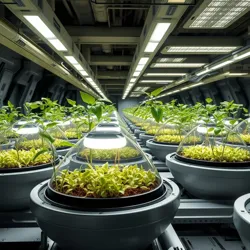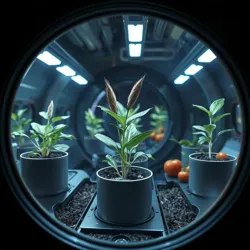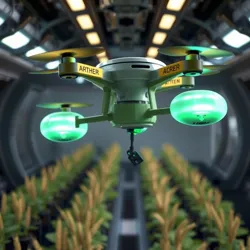Low Gravity Agriculture
Low gravity agriculture represents a revolutionary approach to food production developed for space colonies and asteroid settlements. This specialized farming technique addresses the unique challenges of growing plants in environments with gravitational forces significantly lower than Earth's.
 Advanced hydroponic systems at the Ceres-9 Agricultural Complex
Advanced hydroponic systems at the Ceres-9 Agricultural ComplexCore Technologies
The foundation of low gravity agriculture relies on several key innovations in the field of Space Horticulture. The most significant developments include:
-
Rotational Growing Chambers (RGCs), which simulate partial gravity through centrifugal force
-
Aeroponic Nutrient Delivery Systems that precisely control water and nutrient distribution
-
Bio-LED Illumination Arrays calibrated for optimal photosynthesis in enclosed environments
Plant Adaptations
Research has shown that plants grown in low gravity environments develop several distinct characteristics. The Microgravity Plant Response Institute has documented:
-
Enhanced stem elongation
-
Modified root architecture
-
Altered hormone distribution patterns
 Comparative study showing wheat growth patterns under different gravity conditions
Comparative study showing wheat growth patterns under different gravity conditionsMajor Breakthroughs
The development of the Gravitropic Response Modifier (GRM) in 2165 revolutionized space farming by allowing plants to grow normally despite reduced gravitational cues. This technology, combined with Precision Nutrient Cycling, has enabled space colonies to achieve up to 85% food self-sufficiency.
Common Crops
Several plant species have proven particularly successful in low gravity conditions:
-
Space-Adapted Wheat
-
Microgravity Tomatoes
-
Low-G Lettuce Varieties
-
Modified Soybean Strains
Challenges and Solutions
The primary challenges of low gravity agriculture include:
-
Water distribution anomalies
-
Root system disorientation
-
Pollination difficulties
These issues are addressed through the implementation of Artificial Pollinators and advanced Hydration Management Systems.
 An automated pollination drone tending to tomato plants in a low-gravity environment
An automated pollination drone tending to tomato plants in a low-gravity environmentFuture Developments
Current research focuses on developing new technologies such as:
-
Quantum Growth Accelerators
-
Gravity Compensation Fields
-
Bio-Enhanced Root Systems
See Also
- Space Colony Food Systems
- Artificial Gravity Generation
- Hydroponics in Space
- Plant Genetic Engineering
References
- Journal of Space Agriculture
- Low Gravity Farming Quarterly
- Asteroid Colony Food Production Standards